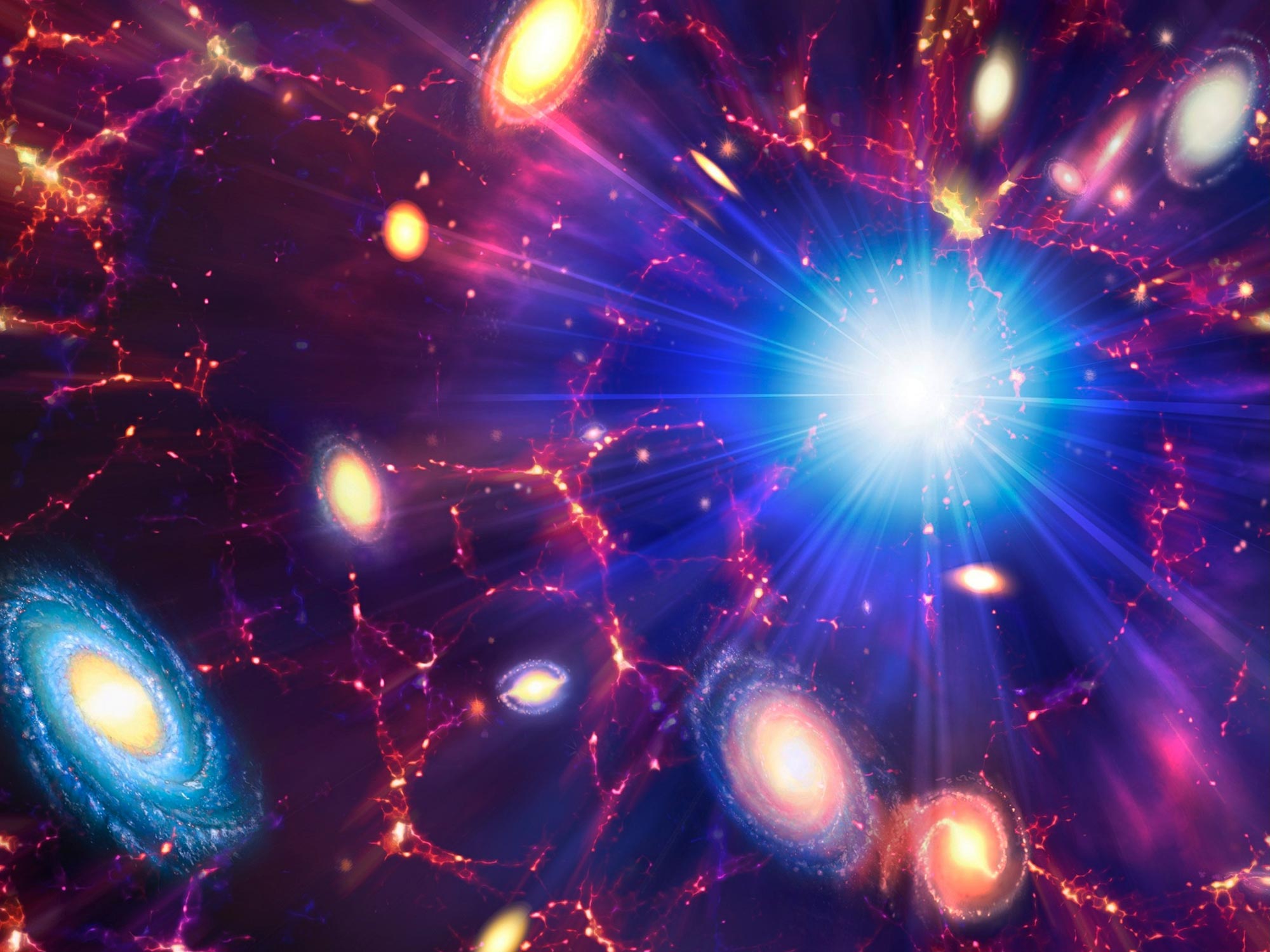
Ein Team von Wissenschaftlern, bestehend aus Experten der University of Chicago und dem Fermi National Accelerator Laboratory, hat mit einer der bisher genauesten Messungen der Verteilung der Materie im Universum einen Spielveränderer erklärt.
Die Analyse kombiniert Dark Energy Survey- und South Pole Telescope-Daten, um die Entwicklung des Universums zu verstehen.
Um herauszufinden, was los ist, muss man es manchmal erst finden.
Als das Universum begann, strömte Materie nach außen und formte nach und nach die Planeten, Sterne und Galaxien, die wir heute kennen und lieben. Indem Wissenschaftler heute sorgfältig eine Karte dieser Materie erstellen, können sie versuchen, die Kräfte zu verstehen, die die Evolution des Universums geformt haben.
Eine Gruppe von Gelehrten, darunter mehrere mit Universität Chicago Und Fermi National Accelerator LaboratorySie veröffentlichten eine der genauesten Messungen, die jemals durchgeführt wurden, um festzustellen, wie Materie heute im Universum verteilt ist.
An der Analyse, die Daten von zwei großen Teleskopdurchmusterungen des Universums, dem Dark Energy Survey und dem Antarctic Telescope, kombinierte, waren mehr als 150 Forscher beteiligt und sie wurde als eine Reihe von drei Artikeln am 31. Januar in der Zeitschrift veröffentlicht körperliche Untersuchung d.
Unter anderem zeigt die Analyse, dass Materie nicht so „klumpig“ ist, wie wir es auf der Grundlage unseres derzeit besten Modells des Universums erwarten würden, was zu den Beweisen beiträgt, dass unserem derzeitigen Standardmodell des Universums etwas fehlen könnte.

Wissenschaftler haben eine neue Übersicht über die gesamte Materie im Universum veröffentlicht, die Daten verwendet, die vom Chile Dark Energy Survey und dem Antarctic Telescope gewonnen wurden. Bildquelle: Foto von Andreas Papadopoulos
Kühlung und Agglomeration
Distanz[{“ attribute=““>Big Bang created all the matter in the universe in a very hot, intense few moments about 13 billion years ago, this matter has been spreading outward, cooling and clumping as it goes. Scientists are very interested in tracing the path of this matter; by seeing where all the matter ended up, they can try to recreate what happened and what forces would have had to have been in play.
The first step is collecting enormous amounts of data with telescopes.
In this study, scientists combined data from two very different telescope surveys: The Dark Energy Survey, which surveyed the sky over six years from a mountaintop in Chile, and the South Pole Telescope, which looks for the faint traces of radiation that are still traveling across the sky from the first few moments of the universe.

The South Pole Telescope is part of a collaboration between Argonne and a number of national labs and universities to measure the CMB, considered the oldest light in the universe. The high altitude and extremely dry conditions of the South Pole keep water vapor from absorbing select light wavelengths. Credit: Image by Argonne National Laboratory
Combining two different methods of looking at the sky reduces the chance that the results are thrown off by an error in one of the forms of measurement. “It functions like a cross-check, so it becomes a much more robust measurement than if you just used one or the other,” said UChicago astrophysicist Chihway Chang, one of the lead authors of the studies.
In both cases, the analysis looked at a phenomenon called gravitational lensing. As light travels across the universe, it can be slightly bent as it passes objects with lots of gravity, like galaxies.
This method catches both regular matter and dark matter—the mysterious form of matter that we have only detected due to its effects on regular matter—because both regular and dark matter exert gravity.
By rigorously analyzing these two sets of data, the scientists could infer where all the matter ended up in the universe. It is more precise than previous measurements—that is, it narrows down the possibilities for where this matter wound up—compared to previous analyses, the authors said.

By overlaying maps of the sky from the Dark Energy Survey telescope (at left) and the South Pole Telescope (at right), the team could assemble a map of how the matter is distributed—crucial to understand the forces that shape the universe. Credit: Image courtesy of Yuuki Omori
The majority of the results fit perfectly with the currently accepted best theory of the universe.
But there are also signs of a crack—one that has been suggested in the past by other analyses, too.
“It seems like there are slightly less fluctuations in the current universe, than we would predict assuming our standard cosmological model anchored to the early universe,” said analysis coauthor and University of Hawaii astrophysicist Eric Baxter (UChicago PhD’14).
That is, if you make a model incorporating all the currently accepted physical laws, then take the readings from the beginning of the universe and extrapolate it forward through time, the results look slightly different from what we actually measure around us today.
“There’s a lot of new things you can do when you combine these different angles of looking at the universe.”
— Chihway Chang, UChicago astrophysicist
Specifically, today’s readings find the universe is less “clumpy”—clustering in certain areas rather than evenly spread out—than the model would predict.
If other studies continue to find the same results, scientists say, it may mean there is something missing from our existing model of the universe, but the results are not yet to the statistical level that scientists consider to be ironclad. That will take further study.
However, the analysis is a landmark as it yielded useful information from two very different telescope surveys. This is a much-anticipated strategy for the future of astrophysics, as more large telescopes come online in the next decades, but few had actually been carried out yet.
“I think this exercise showed both the challenges and benefits of doing these kinds of analyses,” Chang said. “There’s a lot of new things you can do when you combine these different angles of looking at the universe.”
University of Chicago Kavli Associate Fellow Yuuki Omori was also a lead co-author for the papers. The full studies and authorships, “Joint analysis of Dark Energy Survey Year 3 data and CMB lensing from SPT and Planck,” can be found in three papers selected as the editor’s suggestion at Physical Review D.
References:
“Joint analysis of Dark Energy Survey Year 3 data and CMB lensing from SPT and Planck. I. Construction of CMB lensing maps and modeling choices” by Y. Omori et al. (DES and SPT Collaborations), 31 January 2023, Physical Review D.
DOI: 10.1103/PhysRevD.107.023529
“Joint analysis of Dark Energy Survey Year 3 data and CMB lensing from SPT and Planck. II. Cross-correlation measurements and cosmological constraints” by C. Chang et al. (DES & SPT Collaborations), 31 January 2023, Physical Review D.
DOI: 10.1103/PhysRevD.107.023530
“Joint analysis of Dark Energy Survey Year 3 data and CMB lensing from SPT and Planck. III. Combined cosmological constraints” by T. M. C. Abbott et al. (DES and SPT Collaborations), 31 January 2023, Physical Review D.
DOI: 10.1103/PhysRevD.107.023531
The South Pole Telescope is primarily funded by the National Science Foundation and the Department of Energy and is operated by a collaboration led by the University of Chicago. The Dark Energy Survey was an international collaboration coordinated through Fermi National Accelerator Laboratory and funded by the Department of Energy, the National Science Foundation, and many institutions around the world.

„Pop-Kulturaholic. Web-Nerd. Engagierter Social-Media-Praktiker. Reisefanatiker. Schöpfer. Food-Guru.“

/cdn.vox-cdn.com/uploads/chorus_asset/file/24924650/236780_Google_AntiTrust_Trial_Custom_Art_CVirginia__0000_4.png)




More Stories
Die Federal Aviation Administration fordert eine Untersuchung des Misserfolgs bei der Landung der Falcon-9-Rakete von SpaceX
Identische Dinosaurier-Fußabdrücke auf zwei Kontinenten entdeckt
SpaceX startet 21 Starlink-Satelliten mit einer Falcon 9-Rakete von Cape Canaveral aus – SpaceflightNow